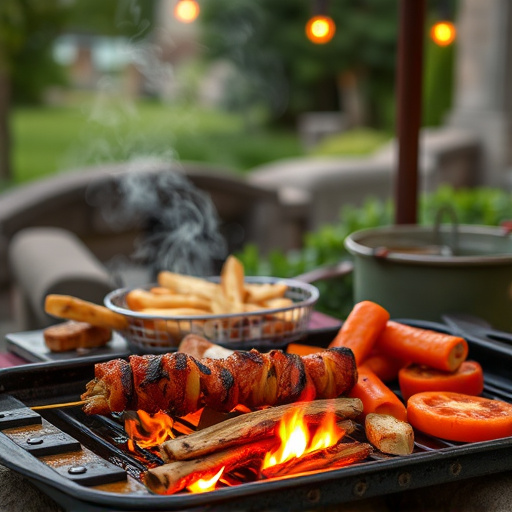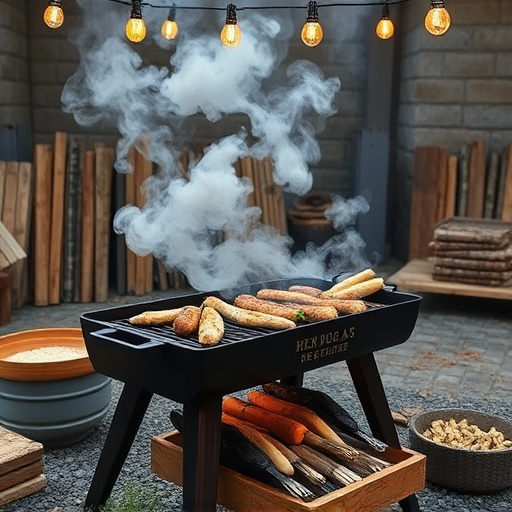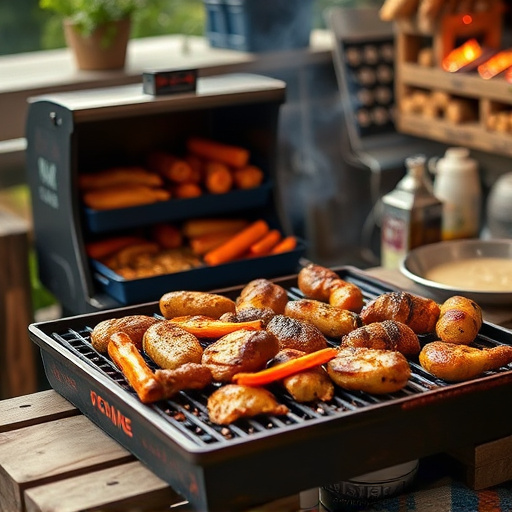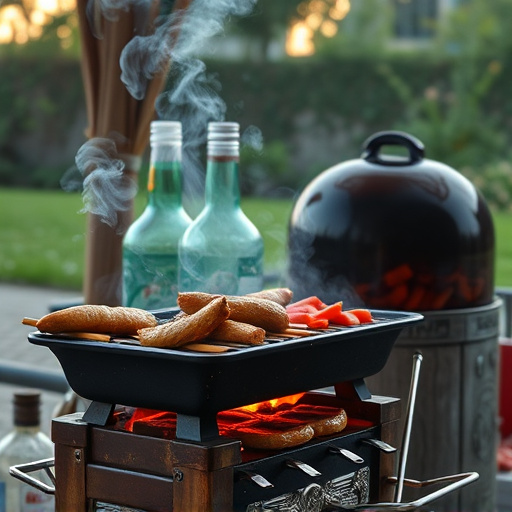Brisket, a flavorful beef cut, is a rewarding but challenging BBQ option for beginners. This guide emphasizes the art of smoking brisket, focusing on its unique marbling and ideal point cut. Essential tools and techniques include investing in quality equipment, using the Dry Rub Technique, maintaining precise smoke and temperature control, and serving the sliced meat with simple sides for a memorable dining experience. The key to success lies in patience and understanding the balance between smoke and temperature, ensuring an easy BBQ brisket recipe that delights your taste buds.
Looking to master the art of smoking brisket but unsure where to start? This guide is your perfect entry point. We’ll walk you through every step, from understanding the cut’s unique qualities to mastering slow-cooking techniques and serving it up like a pro. Learn the essential tools needed for BBQ success and discover the simple dry rub technique that ensures mouthwatering flavor. Get ready to impress with this easy BBQ brisket recipe – perfect for novice pitmasters!
- Understanding Brisket: The Cut and Its Unique Qualities
- Essential Tools and Equipment for BBQ Beginners
- Dry Rub Technique: Seasoning Your Brisket to Perfection
- Slow Cooking Basics: Mastering the Smoke and Temperature
- Slicing and Serving: How to Present Your Delicious Brisket
Understanding Brisket: The Cut and Its Unique Qualities

Brisket, a cut from the beef chuck, is a favorite among barbecue enthusiasts for its rich, savory flavor and tender texture when cooked low and slow. It’s a versatile cut that can be prepared in various ways, but for novices, mastering the art of smoking brisket is an exciting challenge. This easy BBQ brisket recipe is designed to guide first-timers through the process, focusing on the unique qualities of this meaty steak.
The key to unlocking brisket’s potential lies in its marbling—the fat streaks running throughout the muscle. This fat renders during slow cooking, transforming into a mouthwatering, moist environment that tenderizes the meat. The point cut, with its abundant marbling and layer of fat cap, is ideal for beginners as it ensures the brisket stays juicy and flavorful even when smoked at low temperatures for an extended period.
Essential Tools and Equipment for BBQ Beginners

When diving into the world of BBQ, having the right tools is as crucial as mastering the art of cooking. For novices tackling an easy BBQ brisket recipe, a few key pieces of equipment will make your journey smoother and more enjoyable. Start with a reliable smoker—this could be a charcoal or gas model, depending on your preference—and ensure it has a temperature gauge to monitor the heat precisely. A good pair of long-handled tongs is essential for handling the meat without piercing it, preserving those delicious juices.
Don’t forget a meat thermometer; this tool will help you determine when your brisket is cooked to perfection. For an easy BBQ brisket recipe, aim for an internal temperature of 165°F (74°C). Additionally, a set of silicone or nylon kitchen spatulas and a large, heavy-duty aluminum pan will come in handy. These basic tools will enable you to explore the delightful world of BBQ cooking and create mouthwatering brisket dishes with ease.
Dry Rub Technique: Seasoning Your Brisket to Perfection

The Dry Rub Technique is a fundamental step in achieving mouthwatering, perfectly seasoned brisket—an essential skill for any novice trying their hand at easy BBQ brisket recipes. This simple yet effective method involves coating your brisket with a blend of spices before cooking, allowing the flavors to penetrate and enhance the meat’s natural juices. By using a combination of salt, pepper, paprika, garlic, and other aromatic spices, you create a robust seasoning that clings to the meat, resulting in a tender, flavorful end product.
This technique is straightforward but requires precision. First, prepare your dry rub by mixing the spices in a bowl, adjusting the quantities to suit your taste preferences. Then, pat the brisket dry with paper towels before applying an even layer of the rub all over—a trick that helps the seasoning adhere better. This simple step can significantly impact the final flavor profile, making it a crucial part of any easy BBQ brisket recipe for novices to master.
Slow Cooking Basics: Mastering the Smoke and Temperature

Brisket is a cut of meat that requires patience and practice, but with the right techniques, even novices can achieve delicious results in their first attempt at an Easy BBQ Brisket Recipe. One of the key aspects to master when cooking brisket is understanding the relationship between smoke and temperature. The slow-cooking process involves maintaining a consistent low temperature (ideally between 225°F – 250°F or 107°C – 121°C) for several hours, allowing the collagen in the meat to break down and render the fat. This is where smoke comes into play; it adds flavor and helps insulate the brisket, keeping it moist during the long cook.
The ideal scenario is to use a smoker that allows for precise temperature control and a steady smoke flow. Wood chips or chunks, like oak, hickory, or mesquite, can be added to the smoker to infuse the meat with distinct smoky flavors. It’s crucial to monitor the temperature regularly, adjusting the smoke level as needed, especially as the brisket approaches its target internal temperature of around 195-205°F (90-96°C) for maximum tenderness and flavor. This slow and steady approach is the secret to a successful Easy BBQ Brisket Recipe, ensuring that your first attempt turns out mouthwatering and memorable.
Slicing and Serving: How to Present Your Delicious Brisket

When it comes to serving your mouthwatering BBQ brisket, the way you slice and present it can elevate the overall dining experience. For a novice cook, this is an important step to ensure your guests or family enjoy every bite. The key is to slice the meat against the grain, which will make it tender and easier to chew. This technique also allows for a better distribution of fat, adding flavor and juiciness to each slice.
To create visually appealing plates, start by slicing the brisket into thin, even pieces. You can choose to cut it into point cuts or thick slices, depending on your preference. Pairing the brisket with simple sides like coleslaw, potato salad, or baked beans will complement its rich flavor. Presenting the dish on a large plate or platter will allow for a generous serving and create a stunning centerpiece for any meal.
